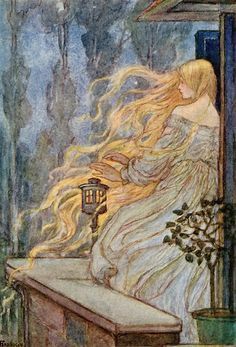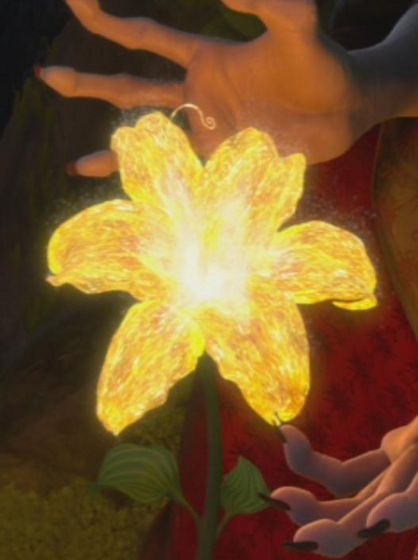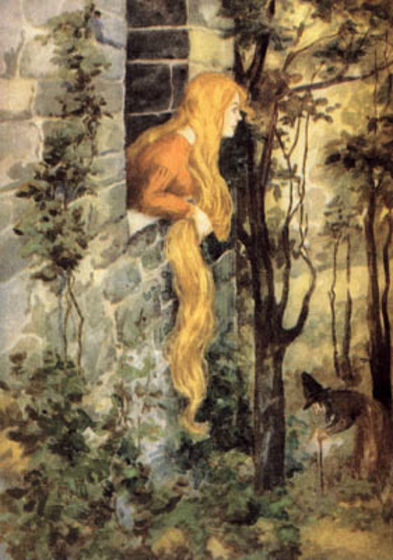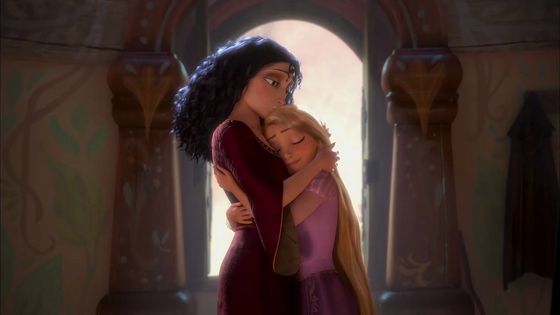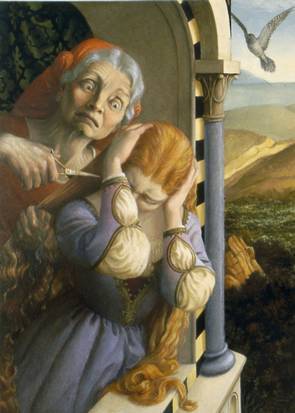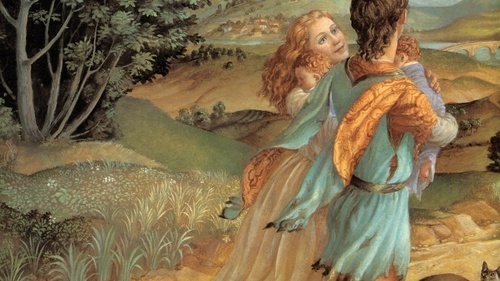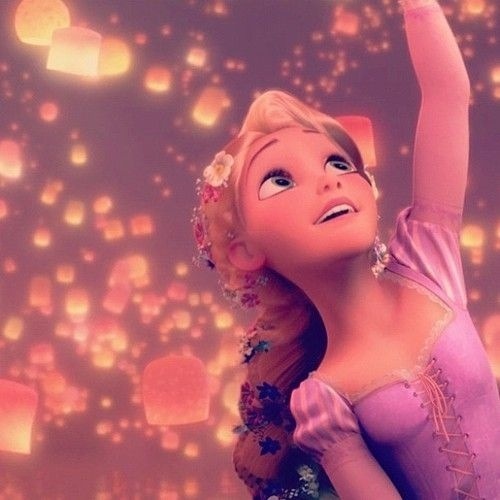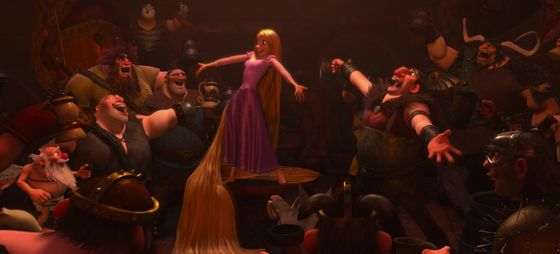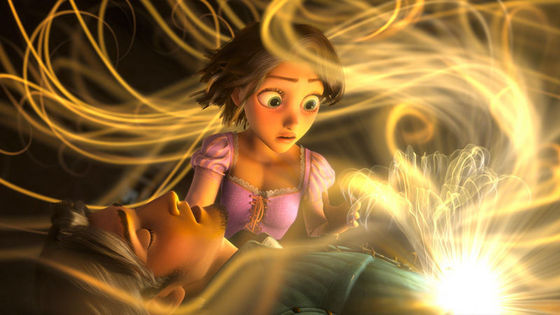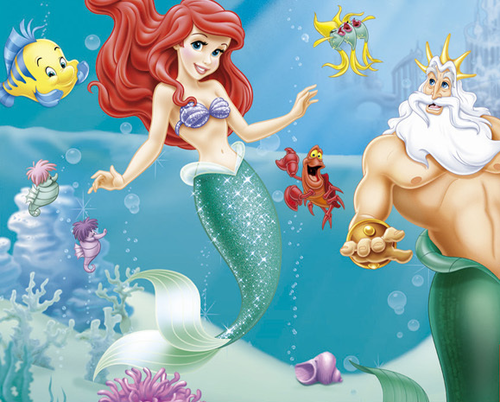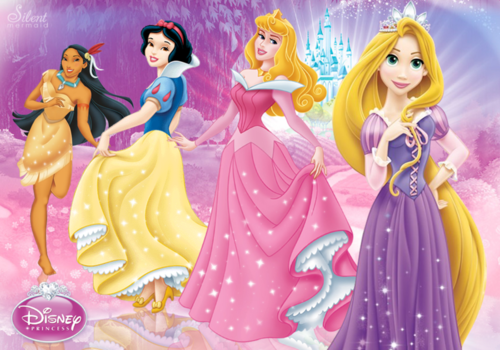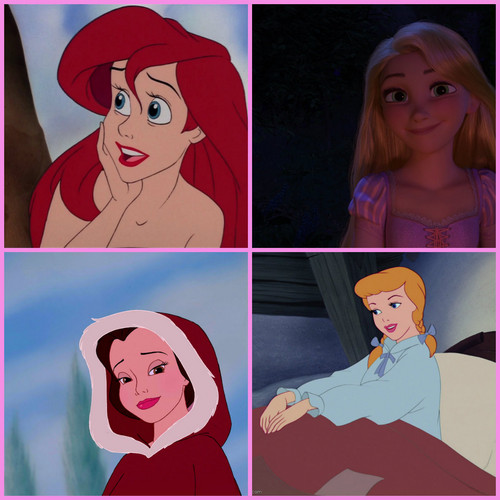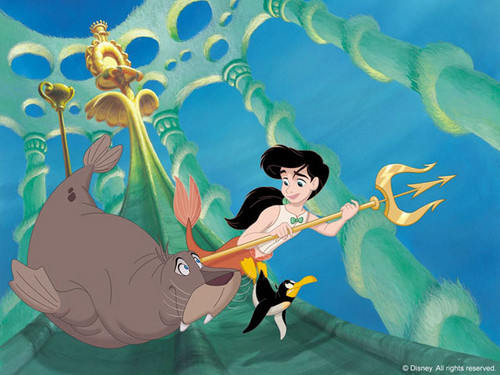“Rapunzel” is the kind of story that consistently ranks highly in people’s lists of their 最喜爱的 fairy tales. With a dramatic plot, interesting characters, symbolic motifs, and the underlying theme of the redeeming power of love, the tale certainly seems to deserve such adoration. Grimm’s version of the story is perhaps the most known retelling, although that may have changed as of 2010 with Disney’s adaptation, Tangled, a movie just as rife with symbolism as its literary inspiration. Although both are variations on the Rapunzel narrative, Disney’s movie veers into a vastly dissimilar direction, achieved through both plot and imagery. In so doing, the audience is left with different 查看 on motherhood, the feminine voice, and Rapunzel’s development as a heroine than if they had read the original German tale.
Tangled opens with voice-over narration that sets up the two most important elements of the movie: “This is the story of a girl named Rapunzel, and it starts with the sun.” Indeed, the sun stands in as the symbolic and literal progenitor of some of the most significant motifs, such as light, healing, inspiration, and goodness. In order to better understand how these are all related, one only needs to listen to the narration that follows that statement. As the voice of Flynn Rider—Grimm’s prince character reworked into a lovable rogue—tells it, a drop of sunlight fell to earth and created a magical, golden 花 with healing capabilities. A witch named Gothel took advantage of this 花 for hundreds of years to reverse her aging, but it was eventually used to heal the region’s sick, pregnant queen. When the 皇后乐队 gave birth to a lovely baby girl with golden blonde hair, Gothel discovered that the princess’s hair retained the flower’s healing magic. Gothel then kidnapped the child and put her in a tower, far removed from the rest of civilization.
Despite being rather exposition-heavy, this opening serves a powerful symbolic role for the film. We as the audience learn that Rapunzel fully embodies the flower’s magic and healing properties, and also that Gothel is actively hiding and exploiting her for that reason. Even more, Rapunzel personifies the sun itself, so the abundance of sun- and light-related imagery throughout the movie comes as no surprise. She is fascinated with lanterns, tracking the cosmos, and sunshine. Meanwhile, whenever Gothel comes onscreen, the older woman removes light sources, shuts windows, and brings literal darkness into the area. Rapunzel clearly represents light, goodness, wonder, and life, while Gothel is darkness, evil, fear, and death.
This setup differs highly from Grimm’s fairy tale, in which Rapunzel’s biological parents traded her to a sorceress in exchange for some lettuce. The mother is presented as being especially at fault for instigating the problem in the first place, controlled 由 her hedonistic impulses. In this way, she represents the archetypical ‘bad mother’. The sorceress, also referred to in some translations as a fairy 或者 wise woman, steps in as the ‘good mother’, overcoming her desires and raising Rapunzel well.
The sorceress in Grimm’s edition lets Rapunzel play outside until puberty, at which point she places the young woman in a tall tower—interpreted 由 many as either phallic imagery 或者 a symbol of her virginity—with no doors 或者 windows, except one high up on the structure. Every day, the old woman climbs up the makeshift rope of Rapunzel’s hair, which itself represents feminine youth and vitality. Why, though, does she isolate Rapunzel to such a degree? One theory is that it serves an educational purpose: being a wise woman with knowledge of herbs and healing, the sorceress wants to train Rapunzel to be one as well. Marriage would clearly hinder Rapunzel’s prospects, so it makes the most sense to keep her locked away from the world.
In Disney’s movie, however, it is clear that Gothel keeps her there purely for selfish reasons. She wants to stay young; therefore, she keeps her magical 花 girl hidden away, as she had done before the plant was 给 to Rapunzel’s actual mother. Furthermore, instead of setting her up as a wise woman, as in Grimm’s story, Gothel is practically the epitome of an overbearing, selfish mother. To deter Rapunzel from ever trying to leave the tower, she frightens the girl into obedience and makes her believe that she would be too fragile to survive in the world. It is nothing but miraculous that Rapunzel is still a functioning, carefree person after eighteen years of Gothel’s relentless teasing, condescension, and passive-aggression. That being said, Gothel has clearly educated Rapunzel and indulged her in countless hobbies (everything from chess to candle-making), even going out of her way to obtain rare paints for her, 展示 that she does at least care about Rapunzel’s happiness to some degree.
Between these two vastly different portrayals of motherhood, it only stands to reason that the daughters would likewise develop into two unique women. Both girls have been raised in seclusion and, thus, are completely ignorant of the outside world. It is this naïveté that leads Grimm’s Rapunzel to become impregnated 由 the first man she meets, a wandering young prince. The sorceress learns of Rapunzel’s condition and cuts off her hair, casting her out into the wilderness. This is suggestive of Rapunzel’s new identity as a grown woman, a mother herself. The prince, when he comes looking for his lover, is met with the sorceress. She casts him out of the tower, where he falls face-first onto some thorns and is blinded. Rapunzel, meanwhile, bears twins and raises them for seven years, at which point the prince stumbles across them all, drawn in 由 the familiar sounds of Rapunzel’s 唱歌 voice. Her tears heal his wounded eyes, which is effectively the culmination of her healing abilities. Two separate ideas of motherhood were presented in the beginning of Grimm’s tale, the biological mother and the sorceress, and at the end Rapunzel becomes a third, an educated woman who heals others through the power of love.
Tangled’s heroine, on the other hand, serves as the light of joy and inspiration for everyone that meets her. With the help of Flynn Rider, a notorious criminal who attempted to hide out in her tower, she ventures into the outside world to see the king and queen’s floating lantern demonstration for the first time, in honor of her eighteenth birthday. Along the way, she singlehandedly charms a room full of thugs into 唱歌 about their hopes for the future, just 由 the force of her natural charisma and sweetness. Moreover, she even inspires Flynn to discuss his sad, lonely childhood and really open up to someone for the first time (of course, this is also indicative of their growing romantic affections for each other).
When she is finally recaptured 由 Mother Gothel and imprisoned in the tower again, Flynn comes to rescue her but is stabbed 由 Gothel. Rapunzel pleads with the woman to let her save Flynn with her healing magic, in exchange for being locked in the tower for the rest of her life. Interestingly, it is Flynn who cuts off Rapunzel’s hair, removing her magical abilities. Gothel’s age suddenly catches up to her and she dies while falling out of the tower, and Rapunzel begins to cry over Flynn’s body. Some of the flower’s magic must have remained in her, because her tear actually brings him back to life. Afterward, she reunites with her long-lost parents, and she and Flynn eventually marry. Despite not being a mother within the narrative, this Rapunzel still manages to overcome her naïveté and becomes a healing presence for everyone, this time because of her personality and not a magical sun flower.
Despite supposedly being derived from Grimm’s story, 魔发奇缘 clearly diverges onto a different path. This only makes sense when one considers the storytellers’ motives in each case. The Brothers Grimm were presenting a coming-of-age story about an exceptionally naïve but well-educated young mother, while 迪士尼 wanted to capitalize on the importance of 爱情 and inner strength. Each tale portrays a different side of motherhood and, likewise, a different happily-ever-after for the protagonist, all framed with different symbolism. With such 流行的 and interesting retellings to choose from, “Rapunzel” as a fairy tale will clearly captivate and educate audiences for years to come.
Tangled opens with voice-over narration that sets up the two most important elements of the movie: “This is the story of a girl named Rapunzel, and it starts with the sun.” Indeed, the sun stands in as the symbolic and literal progenitor of some of the most significant motifs, such as light, healing, inspiration, and goodness. In order to better understand how these are all related, one only needs to listen to the narration that follows that statement. As the voice of Flynn Rider—Grimm’s prince character reworked into a lovable rogue—tells it, a drop of sunlight fell to earth and created a magical, golden 花 with healing capabilities. A witch named Gothel took advantage of this 花 for hundreds of years to reverse her aging, but it was eventually used to heal the region’s sick, pregnant queen. When the 皇后乐队 gave birth to a lovely baby girl with golden blonde hair, Gothel discovered that the princess’s hair retained the flower’s healing magic. Gothel then kidnapped the child and put her in a tower, far removed from the rest of civilization.
Despite being rather exposition-heavy, this opening serves a powerful symbolic role for the film. We as the audience learn that Rapunzel fully embodies the flower’s magic and healing properties, and also that Gothel is actively hiding and exploiting her for that reason. Even more, Rapunzel personifies the sun itself, so the abundance of sun- and light-related imagery throughout the movie comes as no surprise. She is fascinated with lanterns, tracking the cosmos, and sunshine. Meanwhile, whenever Gothel comes onscreen, the older woman removes light sources, shuts windows, and brings literal darkness into the area. Rapunzel clearly represents light, goodness, wonder, and life, while Gothel is darkness, evil, fear, and death.
This setup differs highly from Grimm’s fairy tale, in which Rapunzel’s biological parents traded her to a sorceress in exchange for some lettuce. The mother is presented as being especially at fault for instigating the problem in the first place, controlled 由 her hedonistic impulses. In this way, she represents the archetypical ‘bad mother’. The sorceress, also referred to in some translations as a fairy 或者 wise woman, steps in as the ‘good mother’, overcoming her desires and raising Rapunzel well.
The sorceress in Grimm’s edition lets Rapunzel play outside until puberty, at which point she places the young woman in a tall tower—interpreted 由 many as either phallic imagery 或者 a symbol of her virginity—with no doors 或者 windows, except one high up on the structure. Every day, the old woman climbs up the makeshift rope of Rapunzel’s hair, which itself represents feminine youth and vitality. Why, though, does she isolate Rapunzel to such a degree? One theory is that it serves an educational purpose: being a wise woman with knowledge of herbs and healing, the sorceress wants to train Rapunzel to be one as well. Marriage would clearly hinder Rapunzel’s prospects, so it makes the most sense to keep her locked away from the world.
In Disney’s movie, however, it is clear that Gothel keeps her there purely for selfish reasons. She wants to stay young; therefore, she keeps her magical 花 girl hidden away, as she had done before the plant was 给 to Rapunzel’s actual mother. Furthermore, instead of setting her up as a wise woman, as in Grimm’s story, Gothel is practically the epitome of an overbearing, selfish mother. To deter Rapunzel from ever trying to leave the tower, she frightens the girl into obedience and makes her believe that she would be too fragile to survive in the world. It is nothing but miraculous that Rapunzel is still a functioning, carefree person after eighteen years of Gothel’s relentless teasing, condescension, and passive-aggression. That being said, Gothel has clearly educated Rapunzel and indulged her in countless hobbies (everything from chess to candle-making), even going out of her way to obtain rare paints for her, 展示 that she does at least care about Rapunzel’s happiness to some degree.
Between these two vastly different portrayals of motherhood, it only stands to reason that the daughters would likewise develop into two unique women. Both girls have been raised in seclusion and, thus, are completely ignorant of the outside world. It is this naïveté that leads Grimm’s Rapunzel to become impregnated 由 the first man she meets, a wandering young prince. The sorceress learns of Rapunzel’s condition and cuts off her hair, casting her out into the wilderness. This is suggestive of Rapunzel’s new identity as a grown woman, a mother herself. The prince, when he comes looking for his lover, is met with the sorceress. She casts him out of the tower, where he falls face-first onto some thorns and is blinded. Rapunzel, meanwhile, bears twins and raises them for seven years, at which point the prince stumbles across them all, drawn in 由 the familiar sounds of Rapunzel’s 唱歌 voice. Her tears heal his wounded eyes, which is effectively the culmination of her healing abilities. Two separate ideas of motherhood were presented in the beginning of Grimm’s tale, the biological mother and the sorceress, and at the end Rapunzel becomes a third, an educated woman who heals others through the power of love.
Tangled’s heroine, on the other hand, serves as the light of joy and inspiration for everyone that meets her. With the help of Flynn Rider, a notorious criminal who attempted to hide out in her tower, she ventures into the outside world to see the king and queen’s floating lantern demonstration for the first time, in honor of her eighteenth birthday. Along the way, she singlehandedly charms a room full of thugs into 唱歌 about their hopes for the future, just 由 the force of her natural charisma and sweetness. Moreover, she even inspires Flynn to discuss his sad, lonely childhood and really open up to someone for the first time (of course, this is also indicative of their growing romantic affections for each other).
When she is finally recaptured 由 Mother Gothel and imprisoned in the tower again, Flynn comes to rescue her but is stabbed 由 Gothel. Rapunzel pleads with the woman to let her save Flynn with her healing magic, in exchange for being locked in the tower for the rest of her life. Interestingly, it is Flynn who cuts off Rapunzel’s hair, removing her magical abilities. Gothel’s age suddenly catches up to her and she dies while falling out of the tower, and Rapunzel begins to cry over Flynn’s body. Some of the flower’s magic must have remained in her, because her tear actually brings him back to life. Afterward, she reunites with her long-lost parents, and she and Flynn eventually marry. Despite not being a mother within the narrative, this Rapunzel still manages to overcome her naïveté and becomes a healing presence for everyone, this time because of her personality and not a magical sun flower.
Despite supposedly being derived from Grimm’s story, 魔发奇缘 clearly diverges onto a different path. This only makes sense when one considers the storytellers’ motives in each case. The Brothers Grimm were presenting a coming-of-age story about an exceptionally naïve but well-educated young mother, while 迪士尼 wanted to capitalize on the importance of 爱情 and inner strength. Each tale portrays a different side of motherhood and, likewise, a different happily-ever-after for the protagonist, all framed with different symbolism. With such 流行的 and interesting retellings to choose from, “Rapunzel” as a fairy tale will clearly captivate and educate audiences for years to come.



